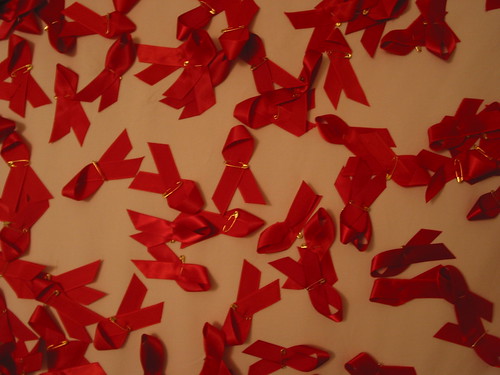End in sight? World AIDS Day 2012
Was good to see street artist Canvaz out and about in Dublin today spreading the message, that this is 'A War We Can Win'. While I'm not so keen on the violent language and imagery, I applaud the sentiment – eradicating AIDS is something that is achievable, now, with the tools and knowledge we already have.
It's easy to fall into using violent terminology – let's beat AIDS, the fight against HIV, the battle against AIDS – but unfortunately this can inadvertently result in increasing stigma and discrimination against people living with HIV. UNAIDS generally advises against this type of language and suggests alternatives in its useful guide to HIV terminology [pdf, 188 KB]. But in some cases strident and powerful imagery and phrases are appropriate and succeed in getting the word out and spurring people into action. This street art piece works well and it gets the message across, when we need to continue to speak out, work together and spread hope about HIV and AIDS in many different contexts.
Art project at the International AIDS Conference, Mexico City, August 2008. 
This year's UNAIDS Report on the Global AIDS Epidemic talked about widescale HIV programmes, prevention tools and treatment that mean the foundation has been laid for "the eventual end of AIDS". That is good news and should encourage us that efforts do have an effect and we could actually stop this disease altogether. But it also tells us we have to keep up and expand this work, not become complacent. In the UNAIDS report, the core document on the state of the pandemic, we learn that there are still 34 million people living with HIV worldwide, which is 0.8% of all the people on Earth aged 15-49. During 2011, 2.5 million people newly acquired HIV – this is a figure that has happily continued to fall in recent years but it is still massive. All of those people will require drug treatment and years of care in the future for them to live. And in 2011, a total of 1.7 million people died from AIDS-related causes. This figure has continued to drop since the mid 2000s because of increased availability of anti-retroviral drug treatment, and because the number of new HIV infections has also been dropping since 1997. These three figures paint a stark picture. Things are improving, but the scale and impact of the problem is still enormous. A lot of people who got HIV in the past year, a lot of people living with HIV and a lot of people dying due to AIDS. A lot of people, for a preventable and treatable disease.
Red ribbon pinned to my chest and another to my cap today, sadly I see few others wearing one. The international theme of World AIDS Day this year is 'Getting to Zero' – zero new HIV infections, zero discrimination and zero AIDS related deaths. It is possible. The special World AIDS Day report had the theme of Results – noting, for example, that there were 700,000 fewer new HIV infections in 2011 than in 2001, and that for the first time more than half (54%) of those eligible for HIV treatment in low and middle income countries were receiving it – a record 8 million people. Hillary Clinton and Barack Obama have launched a blueprint for an AIDS-free generation and the US is contributing major funds towards making it happen. In the future, although we will still remember those who have lost their lives needlessly to this disease, I'd like to think that in ten years, or twenty, no-one will need to wear a red ribbon to raise awareness. That by then we will have ended AIDS.
The effects of HIV and AIDS are not evenly spread worldwide – nearly 1 in 20 adults in sub-Saharan Africa are living with HIV. If you're living in Ireland, the US, or another country with low HIV prevalence, think of 20 of your closest friends and family. How would you feel if one of them had HIV? What would you want to do to help them? If you have 200 friends on your social network of choice, ten of them would be HIV positive. Now try to imagine that for entire societies, where everyone has a family member, a close friend, a work colleague living with HIV, and usually many more than one. Almost everyone is caring for or supporting someone living with HIV or his or her relatives. Almost everyone has attended the funeral of someone who has died due to AIDS-related causes, and has lost members of their own family or knows others who have. This is now and the recent past in many countries. We can stop it from being the future.
Some of my photos related to HIV and AIDS.
My 2011 World AIDS Day blog post.




0 Comments:
Post a Comment
<< Home